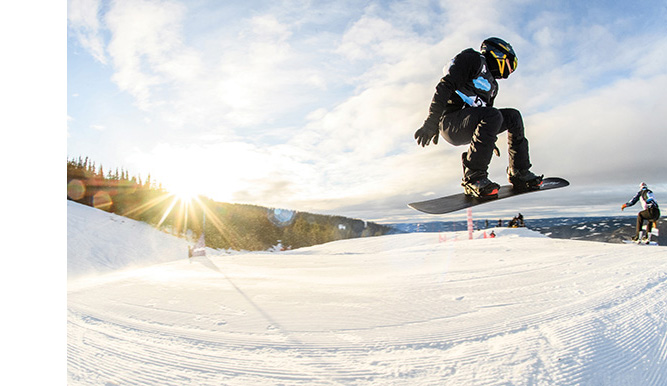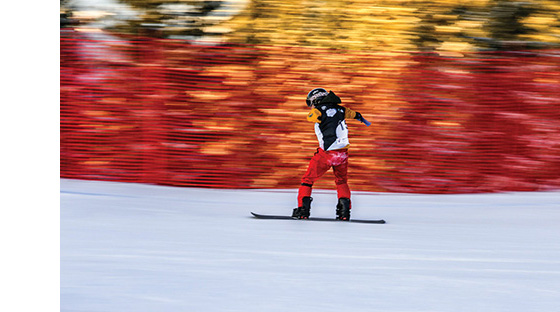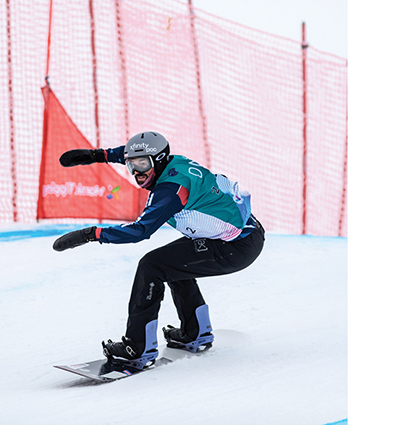By Lacey Henderson
Why should a global Paralympic star have to fight for inclusion against the sport’s governing body?
Boardercross is one of the marquee events of the Winter Paralympics. A pack of snowboarders go full-tilt down a steep, twisting course, jockeying for position through huge jumps and 180-degree turns in a mad dash to the finish line. The race has everything you could ask for in an athletic showcase—speed, strategy, intense pressure, physicality, and an element of danger.

“Boardercross itself is difficult enough, because there’s so many variables with athletes contacting each other at a high rate of speed,” says Mike Schultz, who won Paralympic gold in the event four years ago. “But when you add amputees who are trying to maneuver prosthetic legs around, we just don’t have the ability to react as quickly. There’s a lot higher risk.”
Schultz doesn’t shy away from hazards. A former pro motocross racer (he lost his leg in a motocross race), he’s gone on to excel in gonzo competitions such as snowmobile racing and the ESPN X Games. They call him “Monster Mike” for a reason. But even Schultz admits that boardercross sometimes scares him.
That fear factor makes for thrilling viewing and turns boardercross champions into stars. Schultz won ESPN’s Male Athlete With a Disability award in 2018 after his gold-medal triumph in PyeongChang. Amy Purdy, one of the most famous US paraathletes ever, made her name as a boardercross racer. Brenna Huckaby, the 2018 Paralympic boardcross champion in the women’s above-knee category, parlayed her victory into an appearance in Sports Illustrated’s swimsuit edition.
Given all this, you would think the International Paralympic Committee would have done everything possible to promote boardercross and its stars at the 13th Winter Paralympic Games, which run from March 4 through 13. But no.

For reasons that are difficult to understand, IPC leaders excluded Huckaby’s classification (LL1) from the 2022 Games, leaving her with no way to participate. When she applied for permission to “compete up” in the LL2 classification—racing against athletes with a lower degree of physical impairment—the IPC denied the request. Huckaby finally elbowed her way into the field with the help of a heavyweight sports attorney. She wrote on her Instagram page: “This is a big win for disability inclusion.”
Yes, it’s a big win—but why should the world’s greatest adaptive athletes have to fight for inclusion in the Paralympics? Maybe I misunderstood when I competed at the Summer Rio Games in 2016, but I thought disability inclusion was, like, the whole point of the Paralympic movement. I thought our Games were parallel with the Olympics, a celebration of sport that brings together the greatest athletes on the planet.
Since the Paralympics began in 1960, they’ve grown into the third most popular sporting event in the world. That rapid growth has helped change perceptions of disability, but it may have come at a cost. And it’s Paralympians who are paying the price. Are we the stars in a world-class athletic exhibition? Or are we just mascots in the IPC’s parade of performative inclusion?
WHAT DOES INCLUSION REALLY LOOK LIKE?

If you find it confusing to follow the Paralympics, you’re not alone. The events and classifications are constantly changing, making it hard to understand the context of each competition.
Let’s start with the basics. The 13th Winter Paralympics will feature 78 medal events in six sports: alpine skiing, nordic skiing, biathlon, snowboarding, hockey, and curling. In addition to being divided by gender, Paralympic events also are separated by classification. For example, within snowboarding there are three classifications:
SB-LL1 covers racers with significant impairment to one leg, or impairment in both legs. Above-knee amputees and bilateral below-knee amputees are in this category. I like to think of this category as “missing the use of two joints.”
SB-LL2 encompasses less significant leg impairments. Athletes with a single below-knee amputation compete here.
SB-UL is for snowboarders with upper-limb impairments, including amputation.
These categories are intended to maintain integrity and fairness within each event, ensuring that results are determined by athletic ability rather than by degree of physical impairment. But talent doesn’t always fit neatly into these confirmed categories, and the IPC doesn’t always do its part to promote robust competition in each classification.
That’s how Huckaby almost fell through the cracks. As an above-knee amputee, she competes in the women’s SB-LL1 classification. But three years ago, the IPC cut that classification from the Beijing schedule because it failed to meet the viability requirement at the 2019 World Para Snowboarding Championships. Ditto the women’s SB-UL classification. Neither category attracted enough participants at the 2019 Worlds to constitute a competitive field. But since 2019 came immediately after a Paralympic year, many competitors were understandably on hiatus, so it’s not surprising that participation was down.
The IPC claims it was simply following the eligibility rulebook. But it isn’t always a passive bystander when participation dips in a particular classification. In the weeks leading up to the Tokyo Paralympics last summer, the IPC actively solicited entrants in the some of the men’s track and field categories in order to nudge them over the viability threshold. Not all of the athletes who received those invitations were top competitors. Some were just bodies to fill a lane in a race. But the IPC went out of its way to include them anyway.

Maybe it could have done the same in women’s SB-LL1 to make sure Huckaby’s event stayed viable for Beijing. Or it could have granted Huckaby a waiver allowing her to compete in LL2, where she would have been at a physical disadvantage. Instead, the IPC went out of its way to prevent her from competing at all. Why?
Here’s how IPC president Andrew Parsons explained it in a formal statement: “It goes without saying that the IPC is understanding of Brenna’s cause. She is a world-class athlete and a Paralympic champion who is desperate to compete and represent her country at the very highest level. But she is not alone in wanting to do this. Across the world, there are thousands of Para athletes who want to compete in the Paralympic Games. However, due to the nature of the event—the pinnacle of para sport—not every sport class and sport event can be included. As a result, there are always athletes who miss out and are disappointed.”
Trumpeting the value of “inclusion,” but then excluding world-class performers, is the exact antithesis of the IPC’s own goals. A few years ago, when Parsons announced the organization’s new strategic direction, he said: “Para athletes, fair and competitive sport, and strategic partnerships represent core pillars of the Paralympic Movement that are essential to safeguarding its long-term integrity and development.” But the IPC’s actions in Huckaby’s case undermine two of those pillars, paraathletes and competitive sport. When the best performers can’t even get to the starting gate, it completely subverts the results.
By fighting for her right to participate, Huckaby demonstrated the principles the IPC claims to (and should) stand for. When a German court finally issued an injunction that allowed her to compete in Beijing, Huckaby told ESPN: “I am grateful the court recognized . . . the broader impact of prioritizing inclusion. While this was a big win, there is always more work to be done, and I hope that this reminds adaptive athletes and the disabled community more broadly to never give up on our fight for inclusion.”
RAISING OUR GAME
Athletes at the Paralympic level are professional-caliber performers. We aren’t athletes because we have disabilities. We’re elite athletes who happen to have disabilities. With paraathletes in many nations (including the US) receiving the same medal bonuses as their Olympic counterparts, and national para teams demanding more resources, the stakes are higher than ever. In this type of environment, competitive integrity is paramount. The unique challenge the IPC faces is to reward excellence and give the world’s best athletes a fair chance to shine. Doing this while ensuring equity among varying disability classifications requires some creativity. The IPC needs to show more of that if it wants to live up to its self-proclaimed role as a leader for inclusion.
Instead, the IPC treats inclusion like a PR campaign. Rather than allowing the competition to speak for itself, it enlists strategic partners to tell the stories of Paralympic athletes—our stories—to promote growth. It’s the athletes who deserve to drive this narrative. Let our performances in the arena determine who wins and who loses.
The Paralympics are both a global sporting event and a social movement for inclusion of people with disabilities. But if IPC treats the participants as mascots for disability, rather than elite competitors, the Paralympics will fail on both counts. They won’t be compelling sport, and they won’t truly change attitudes about disability. By creating artificial barriers that exclude elite performers like Huckaby, the IPC is simply reinforcing negative perceptions about disability.
As Paralympians, we’ve raised our game to a world-class level. The IPC needs to do the same.
Lacey Henderson competed in the long jump at the 2016 Paralympic Games. She hosts the Picked Last in Gym Class podcast.



